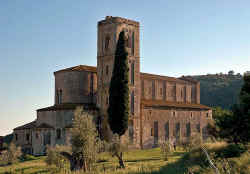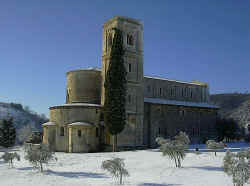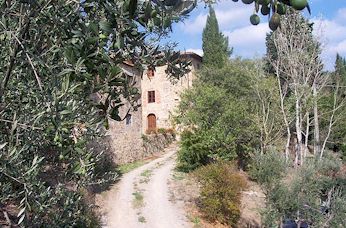|
Abbazia di Sant'Antimo
Abbey of S. Antimo
The
Abbey of Sant'Antimo, one of the most beautiful Romanesque churches in Italy, is
located only 9 km from Montalcino.
According to tradition, in 781 Charlemagne was returning from Rome along the
Via
Francigena. While camped near Monte Amiata, many in his court and army were struck
down by plague. During the night, an angel appeared to the Emperor in dream
and recommended that he pick a particular grass, dry it and then make an infusion with some wine
and have it drunk by the soldiers. He did this and the army was cured. The grass
is known to this day as "Carolina". In return for an end to this scourge, the
Emperor
promised to found the abbey.
According to historians, the foundation goes further back, to the
Longobards and the Monastery of St. Savior
(Salvatoris) at Monte Amiata. It is possible that the Abbey of
Sant'Antimo was constructed on the site of a Roman villa and
it is known with certainty that in the 4th and 5th centuries the village
of Castelnuovo dell'Abate, on the hills nearby, was an important inhabited centre,
endowed with a parish.
The monastery of Sant'Antimo was in existence in the year 814, as
indicated by a
document from one Ludovico the Pious that endows the abbey with gifts and privileges.
In the 9 C, the abbey faced financial difficulty, to the point that in the 877 Charles
II, "the Bald", entrusted it to the Bishop of Arezzo, with the obligation to maintain 40
monks there at his own expense. From the 10 C, the abbot of the monastery
was also the Count Palatino, a public position of great importance conferred by the
Emperor.
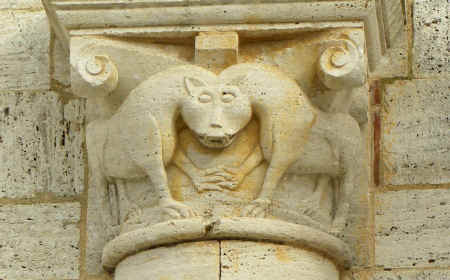
External capital at Sant'Antimo
In 992, according to a deed emanating from Pope John XV (985-996), the monastery
passed into the direct jurisdiction of the Apostolic See. The year 1118 saw the beginning of the
golden years of Sant'Antimo. Count Bernard degli
Ardengheschi surrendered his entire patrimony in goods and property,
including the Abbey, "in toto I reign Italic et in tota Tuscie marks" to
Hildebrand,
son of Rustic. A testimony to this exceptional donation was engraved on the steps of the altar as
a perpetual memorial of the event. The Abbot Guidone (1108-1128), who received the donation, immediately
initiated the great era of the construction of the new church, the Abbey
of Sant'Antimo. The apse of the original
9th century abbey still stands alongside, and is dwarfed by, the new 12 C. The Abbey became the most powerful monastic landowner and foundation in Tuscany, via its imperial connections and gifts from those travelling the nearby
Via Francigena, the pilgrims' route to Rome. At its height, the Abbey owned large tracts of eastern Tuscany from
Lucca
in the north to
Orbetello in the south.

The interior of Sant'Antimo
The great years lasted up until the fall of Montalcino, on 12th June 1212,
to the Siennese who forced the abbey to sign a treaty surrendering a
quarter of the territory of Montalcino in Siena. The abbey then began its slow decline. Entrusted to the
Guglelmiti by Pope Nicholas IV (1288-1292) in a deed dated 23rd August 1291, a brief
recovery occurred in the period from between 1397 and 1404 up to the suppression
of the abbey in 1462 by
Pope
Pius II "Piccolomini" (1458-1464) who entrusted it to the bishop of the newborn diocese of Montalcino and Pienza, created
on 13th August of the same year.
In 1866, the Italian government decreed the general suppression of the religious orders.
The monastic community was transferred to Pescia, where it remained up to 1949. It was only in 1961 that it could
re-enter in the Abbey of Sant'Antimo, whose ownership has remained nevertheless
with the State. After the transfer of the abbey to the ownership of the
new Italian state in 1867, a long period of physical restoration began
that ultimately saved the whole building. The restoration was initiated in 1872 and finished in 1895, bringing the church to
its current appearance. In 1992 religious activity was reinitiated thanks to the arrival of the Regular Canons Premonstratensi.
No description or pictures can do more that provide a pale reflection of charm of this place. The façade,
which remains incomplete, houses a portal, probably one of a pair planned
originally, surmounted by a lintel datable to the first half the 12 C,
together with capitals, friezes and ferrules. The element that confers a French imprint
on this church more than any other is the basilical ground plan, an
ambulatory with radial chapels, unique in Tuscany and among the few
present in Italy. In the morning, the sun plays on the ambulatory stonework
which is the most precious among all those used for the church: alabaster
plus travertine from which the capitals and columns are carved. The impact
of the light streaming in is accentuated by the nave floor which slopes slightly upwards towards the focus of the dramatic
13 C Crucifix standing behind the altar.
The church is long at 44 m, and is guarded at the entry by two stylised lions,
probably destined for the external portal, datable to the 12 C and attributed to the
Master of Cabestany, as is the splendid capital with the scenes of "Daniel in the
lions' den." The refined geometrical and leaf motifs, precise in
outline and cleanly carved, indicate an origin in Auvergne.
Other capitals located in the ambulatory exhibit a Lombard character
suggesting that Sant'Antimo was the work of two masters, or a Lombard who
had worked in Auvergne.
To the right of the larger church, set at the beginning of the ambulatory,
there is a Carolingian chapel of the 8 C or 9 C, a small building
with a single rectangular aisle and a semicircular apse. Outside on the left, the imposing bell tower
rise to around 30 m, divided into four orders, decorated in Lombard style with a
with a hint of Pisan taste in the columns at the angles of the base. The bell tower
houses two bells, one of which is engraved with Abbot Ugo's name
(1216-1222) and the date 1219.
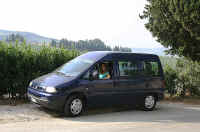 |
Private and shared minibus tours (up to 8 persons)to
Montalcino and Sant'Antimo
with Angela Saltafuori
Write down this phone number!
Tel: (+39)
333
318 5705
|
|
• Full day private and shared wine tours from Florence and nearby to Brunello
di Montalcino wineries. This tour includes a visit to
Sant'Antimo and if timing can be coordinated there is an
opportunity to hear the Gregorian Chant practised by the monks.
Fixed prices offered.
• Full day sight-seeing tours from Florence and nearby to the
Crete Senesi - Montalcino, Montepulciano, Pienza, Colle di Val
d'Elsa, Abbey of Monte Oliveto Maggiore. Fixed prices offered.
More
about Angie's minibus tours
|
|
|
